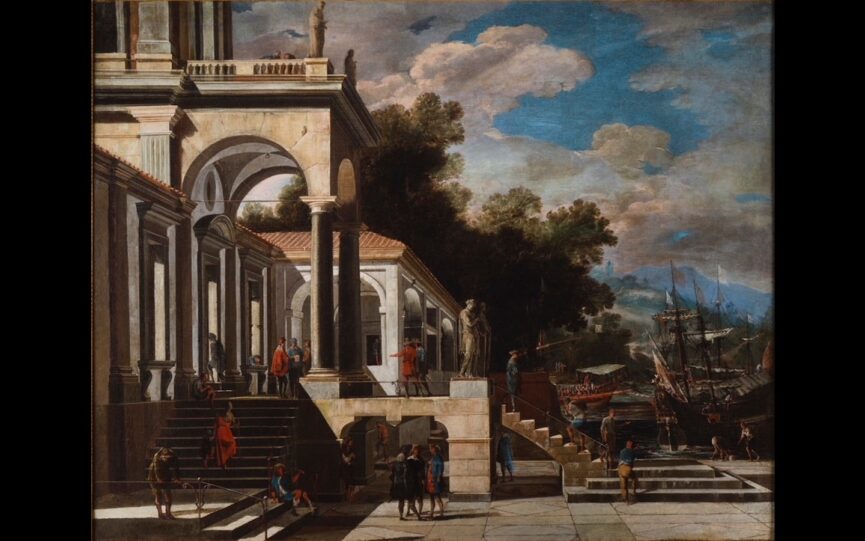VIVIANO CODAZZI (Bergamo 1604 - Rome 1670) and DOMENICO GARGIULIO called MICCO SPADARO (Naples 1612 - 1679)
Elegant figures on a terrace of a palace before a busy harbour with galleys
Oil on canvas: 40 1/8 x 51 3/8 in. 102.5 x 130.5 cm. Fine Empire carved wood frame
Provenance: Dr.David Marshall, Professor of Fine Arts at the University of Melbourne, has confirmed the authorship of Codazzi and Gargiulo on the basis of photographs, dating the painting to the 1640’s.
Codazzi was the foremost capriccio painter of his generation, translating the tenebrist language of Caravaggio into a fresh architectural idiom. After a long period in Rome he arrived in Naples circa 1634, and began to develop the theme of the architectural fantasy, building on the prototypes of Agostino Tassi in his easel pictures, but adding much realistic detail. Codazzi must have known Tassi’s ‘quadratura’ work: in 1638 he painted the architecture for the Pool of Bethesda in Lanfranco’s fresco in SS Apostoli.
Codazzi work for the Certosa di San Martino (1636-1647) is fully documented. In 1647 he fled to Rome to escape the Masaniello revolt, leaving his work unfinished, which led to a long dispute with the monks over payment. In the Sacristy of San Martino Codazzi painted a colonnade in perspective for the Crucifixion of Cavaliere d’Arpino and a colonnade with staircase for Stanzione’s Ecce Homo. According to the documents, the designs for the architecture painted by Codazzi were provided by the architect Cosimo Fanzago, a close friend of his – both came from Bergamo.
In Naples Codazzi worked in close collaboration with the most important painters of the time. For Artemesia Gentileschi he painted the architecture in S.Gennnaro in the Arena (Duomo, Pozzuoli). His well-documented collaboration with Micco Spadaro, a pupil of Salvator Rosa, was particularly successful. The results of this collaboration are listed in the inventories of many 17th.century Neapolitan private collections and some examples are now in the galleries at Besancon, Madrid and Dresden.
Codazzi founded a school of architectural painting which included hitherto little known contemporaries such as Francesco Maglioli and Ascanio Luciano. Their work has often been given to Codazzi, and it is only due to recent research by Dr.Marshall that they have emerged from the shadow of their master and been given a voice of their own. Later interpreters of his style, employing a more baroque idiom, include Carlieri, Ghisolfi, Salucci, Coccorante and Gennaro Greco.

